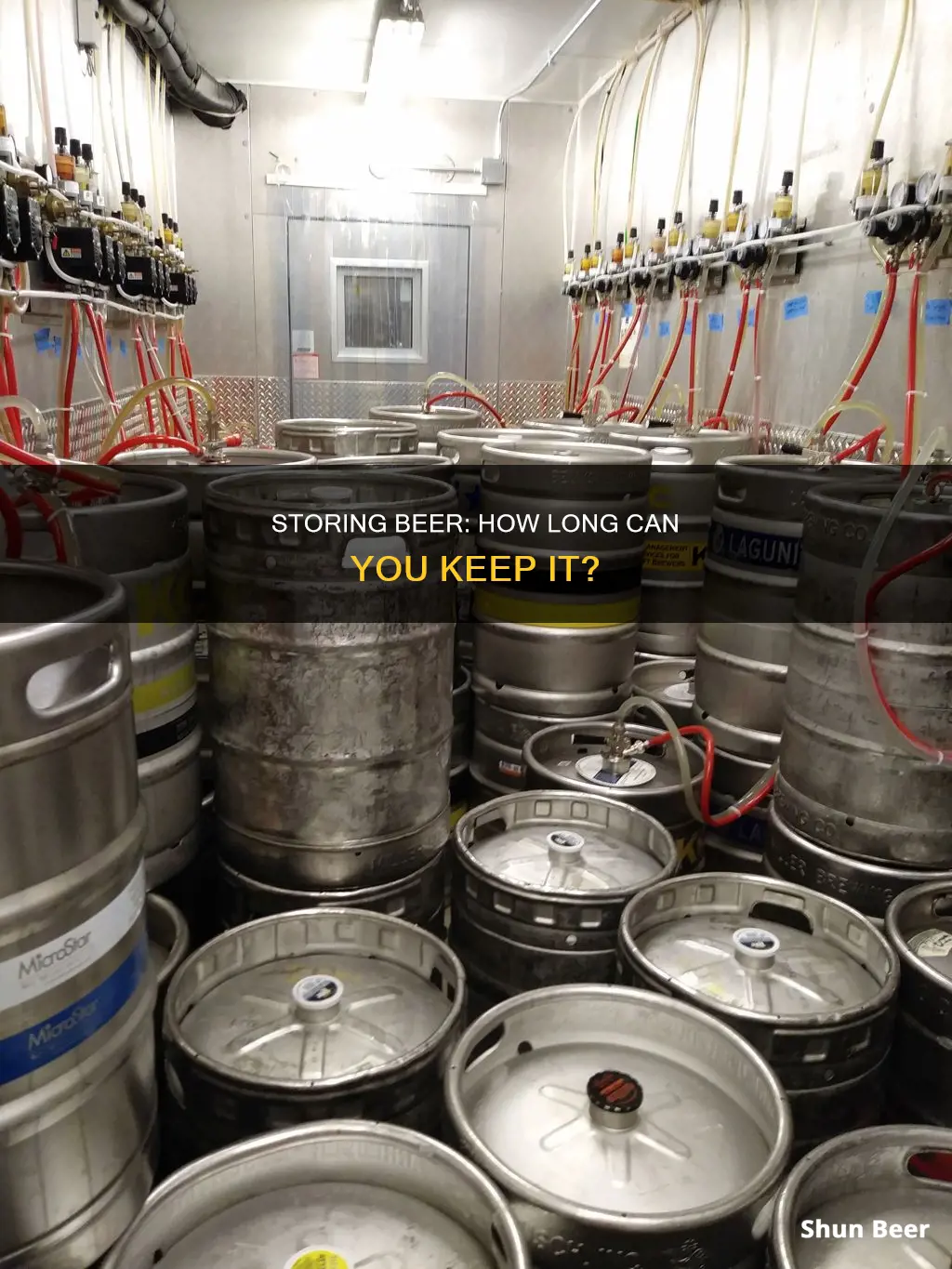
Beer is best served cold, but what happens when it's been left out of the fridge? Can you still drink it? The short answer is yes, but the quality will likely have diminished. Beer is best preserved when kept cold, and keeping it at room temperature can reduce its shelf life from nearly six months to just a few weeks. Exposure to warm temperatures affects its flavour, and you may notice that hop flavours and aromas are diminished, while malt flavours can begin to taste like generic sickly sweet flavours. In some beers, you may even detect reminders of wet cardboard and paper.
What You'll Learn

Beer storage: the best-before date, packaging, and temperature
Beer storage is a complex topic, with many factors influencing how long your beer will last and how good it will taste. Here is a guide to the best-before date, packaging, and temperature of beer storage.
Best-Before Date
The best-before date on beer is a good indicator of when the beer will start to decline in quality. However, this is not a hard-and-fast rule, and beer can last beyond its best-before date if stored correctly. In general, beers with a low alcohol content have a shelf life of up to 6 months, while those with a high alcohol content can last up to 1-2 years, especially if unopened.
Packaging
The type of packaging your beer comes in can impact its shelf life. Canned beer typically offers a longer shelf life than bottled beer due to its sealed and lightless nature, which protects the beer from oxidizing and developing off-flavours. Bottled beer is best stored in a cool, dry, and dark place, with upright storage being optimal to minimize oxidation. Brown bottles are preferable to green or clear bottles as they block out more ultraviolet rays, which can cause "skunking" and spoil the beer.
Temperature
Temperature plays a crucial role in beer storage. Storing beer at cool temperatures can help extend its shelf life and maintain its freshness. The optimal temperature range for storing beer is between 45 and 55 degrees Fahrenheit (7-13 degrees Celsius). Refrigeration is ideal, but if that is not possible, a cool, dark place away from direct sunlight and heat sources is recommended. Freezing beer should be avoided as it can cause haze and affect the texture and mouthfeel.
Other Considerations
In addition to the above, there are a few other factors to consider for optimal beer storage:
- Avoid exposure to sunlight and fluorescent light, as this can cause "skunking" and spoil the beer.
- Store beer upright to minimize air contact and reduce oxidation.
- Consume beer within 3 to 6 months of the expiration date for optimal taste and quality.
- Beer with a higher alcohol content, such as sour, smoked, or high-ABV beers, generally has a longer shelf life.
Gluten-Free Beer: Enjoy Drinking Without Worry
You may want to see also

Beer exposed to oxygen: the impact on taste
Oxygen is the enemy of bright and expressive beer flavours. Exposure to oxygen can happen anywhere in the brewing process, from the brewhouse to the fermentation cellar, the packaging line, and even within the bottle during storage. Oxygen exposure leads to a breakdown of the beer's chemicals, which can significantly alter its taste.
The Beer Judge Certification Program (BJCP) describes oxidised beer as having "any one or a combination of stale, winy/vinous, cardboard, papery, or sherry-like aromas and flavours". Oxidation is generally considered ruinous to beer, but on rare occasions, it can improve certain beers when deliberately employed under controlled conditions, such as during the long vat storage and barrel ageing of lambics prior to bottling.
The process of oxidation accelerates with an increase in temperature. The higher the temperature, the faster the beer will become stale. For example, a beer with a shelf life of four months at 6°C (42°F) may have a shelf life of less than three months at 30°C (86°F). Oxygen can react with melanoidins, which are created during the malting process and the kettle boil, giving the beer a slight taste of sherry. In cold brew, oxygen can turn alcohol into almond-tasting aldehydes.
To avoid oxidation, beer should be stored in a cool, dark place, ideally between 45 and 55 degrees Fahrenheit for packaged beer. Bottled beer should be stored upright to minimise contact with air, as storing beer on its side makes it prone to air leaks. Canned beer is at a lower risk of oxygen exposure than bottled beer.
Beer and Hyperthyroidism: What You Need to Know
You may want to see also

Beer and bacteria: what to watch out for
Beer is susceptible to bacterial contamination, but it's important to note that this is less common in commercial beers due to the rigorous processes employed to minimise bacterial contact. However, it's still crucial to be vigilant about the signs of bacterial growth in your beer, especially if you're consuming craft beer or home-brewed varieties.
Beer is an organic substance that contains yeast, an ingredient that makes it a favourable environment for bacterial growth. If bacteria find their way into your beer, they will feed on it, causing it to spoil. This process can alter the taste, making it flat or unpleasant. Additionally, the presence of bacteria can lead to a mild stomachache if consumed.
Preventing and Identifying Bacterial Growth
To reduce the risk of bacterial growth, it is recommended to refrigerate your beer, especially craft beer. Lower temperatures slow down the life cycle of microbes, including yeast, thereby prolonging the shelf life of your beer.
When it comes to identifying potential bacterial contamination, there are several signs to look out for:
- Lack of "psst" Noise: Fresh beer is characterised by the familiar "psst" noise when opened, accompanied by the ascent of white foam.
- Flat Taste: Even if the beer initially foams, a flat or off taste could indicate bacterial growth.
- Faded Label: A faded or discoloured label suggests that the beer has likely exceeded its best-before date and may be prone to bacterial growth.
- Sediment: The presence of sediment settled at the bottom of the bottle is a sign that the beer should be avoided.
- Leakage: Seepage around the bottle opening could indicate that the beer has been subjected to extreme heat, creating an environment conducive to bacterial growth.
In summary, while bacterial growth in beer is not common, it is important to be vigilant about the signs of contamination. By refrigerating your beer and inspecting it before consumption, you can minimise the risk of encountering unpleasant flavours or potential stomach discomfort associated with bacterial growth.
Beer and the HCG Diet: What You Need to Know
You may want to see also

Storing opened beer: preventing oxidation and loss of carbonation
Once a beer has been opened, it will begin to lose carbonation and will soon go flat. The beer will also begin to oxidise, which will change its taste. To prevent this, you can try the following:
Reseal the bottle
Use an airtight cap or stopper to reduce oxidation and prevent carbonation loss. The smaller the air gap in the bottle, the faster the pressure will build, so if there's only a small amount of beer left, transfer it to a smaller bottle.
Use an inert gas
For non-carbonated drinks, a common method to combat oxidation in an opened bottle is to remove the air from the bottle using a vacuum pump. However, this is a bad idea for carbonated drinks, as the lower pressure will cause the drink to go flat. Instead, replace the air with an inert gas, such as carbon dioxide or nitrogen.
Upside-down storage
If you have a screw-top glass beer bottle, immediately screw the cap back on as tightly as possible and store the bottle upside-down in the fridge. The pressure won't escape because the cap only has to be liquid-tight, not air-tight. This method will keep the beer fizzy for at least a week.
Transfer to a smaller container
If you can't finish a large bottle of beer in one sitting, pour what you're not going to drink into a smaller container and store it in the fridge. This will keep it fresh for 2-3 days, and even at 7 days it will only be a bit flat.
Use a teaspoon or a fork
Although this method has been debunked, some people believe that putting a teaspoon or a fork in the bottle will help to keep the beer carbonated for longer.
Sparkling water maker
If you have access to a sparkling water maker, you can use it to force-carbonate your beer. However, you must keep it cold and sealed to prevent oxygen or sunlight from degrading the flavour.
Grolsch bottles
If you want to drink half a large bottle of beer today and save the rest for tomorrow, transfer it to two smaller Grolsch bottles.
Use a cork
Pour the beer you want into a glass, cork the bottle and return it to the fridge.
Use a growler
A growler is a container that can keep beer fresh for several days and even longer if filled with carbon dioxide. Once opened, the beer will stay fresh for up to 36 hours.
Root Beer and Breastfeeding: Is It Safe?
You may want to see also

Beer storage myths: fact-checking popular beliefs
There are many misconceptions about storing beer. Proper storage is essential to prevent common issues such as spoilage and knowing when a beer has gone bad. Here are some myths about beer storage, fact-checked:
Myth 1: Beer can be safely stored at room temperature
Fact-checked: False. Beer is best stored in a cool, dry place, ideally between 45 and 55 degrees Fahrenheit for packaged beer. Storing beer at room temperature can drastically reduce its shelf life and expose it to potential spoilage.
Myth 2: Beer can be stored in any container
Fact-checked: False. The type of container matters. Beer should be stored in an airtight container, such as a bottle, can, keg, or growler, and kept upright to minimise air contact and oxidation.
Myth 3: All beers can be aged or cellared
Fact-checked: False. Not all beers age the same. Lighter, hoppier beers like IPAs and wheat beers are best enjoyed fresh, as the hops will break down over time. On the other hand, full-bodied, high-ABV beers typically age well under the right conditions.
Myth 4: Beer can be stored in direct sunlight
Fact-checked: False. Beer should be stored away from direct sunlight and fluorescent light to prevent "skunking." Sunlight and UV rays can cause a chemical reaction, breaking down the flavour components and causing the beer to taste and smell like skunk spray.
Myth 5: Opened beer cannot be stored
Fact-checked: It depends. Opened beer can be stored, but it is best to consume it as soon as possible. To preserve the quality of opened beer, reseal it with an airtight cap or stopper to reduce oxidation and prevent carbonation loss. Storing in a cool, dry place can also help prolong its shelf life.
Beer Left Out: Still Safe to Drink?
You may want to see also
Frequently asked questions
Yes, you can drink expired beer, but it might not taste very good. Beer doesn't last forever, and its flavour and aroma will deteriorate over time.
Beer is best when consumed fresh, but it can be stored for up to eight months in the fridge, or six months at room temperature.
Beer should be stored upright in a cool, dark place, ideally between 45 and 55 degrees Fahrenheit.
There are a few signs that your beer has gone bad. These include a flat taste, a faded label, sediment at the bottom of the bottle, or leakage around the bottle opening.







